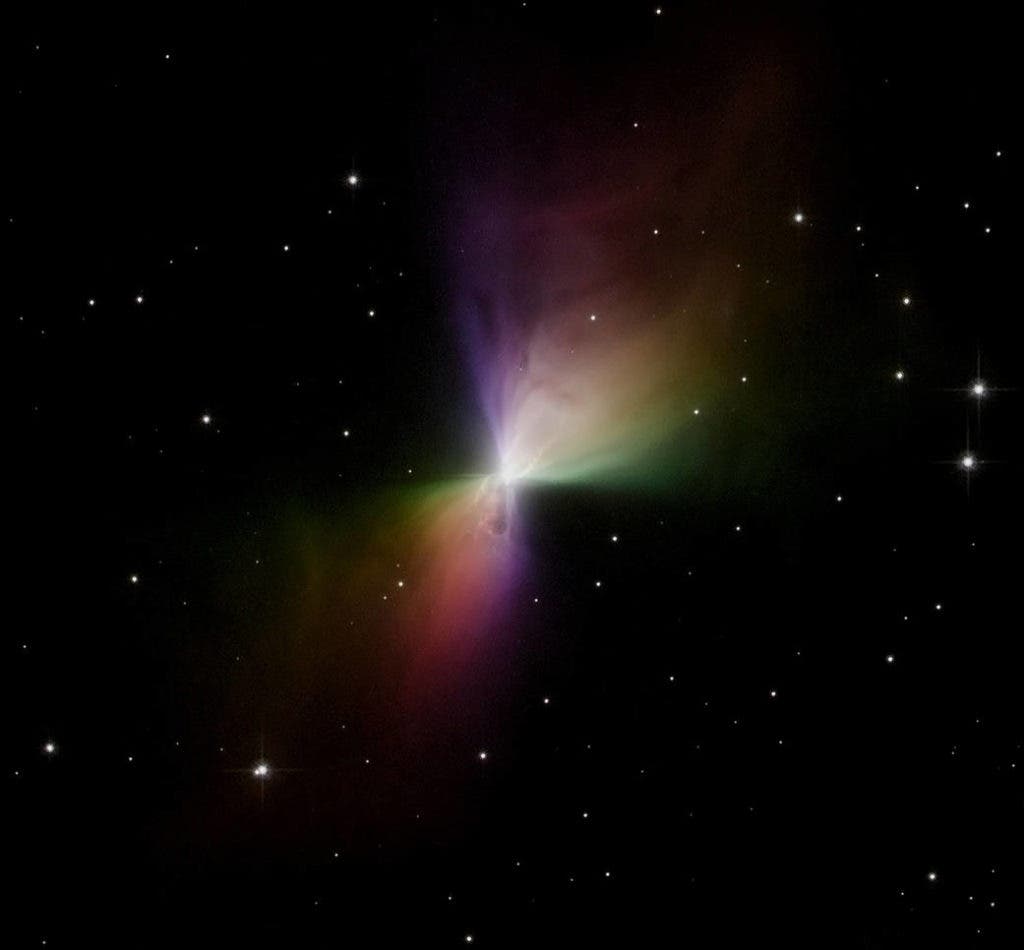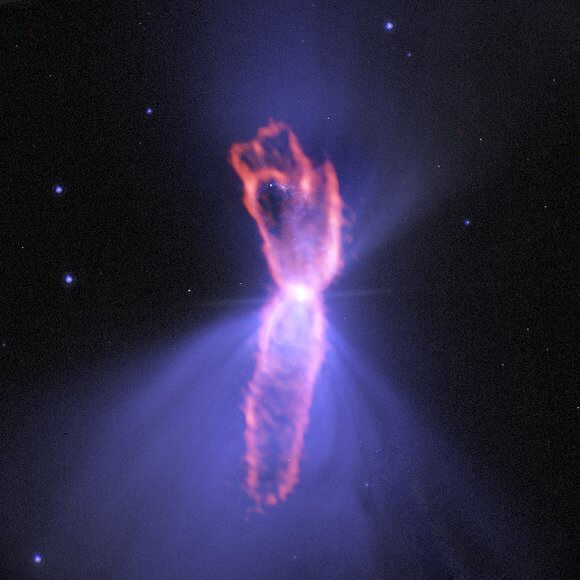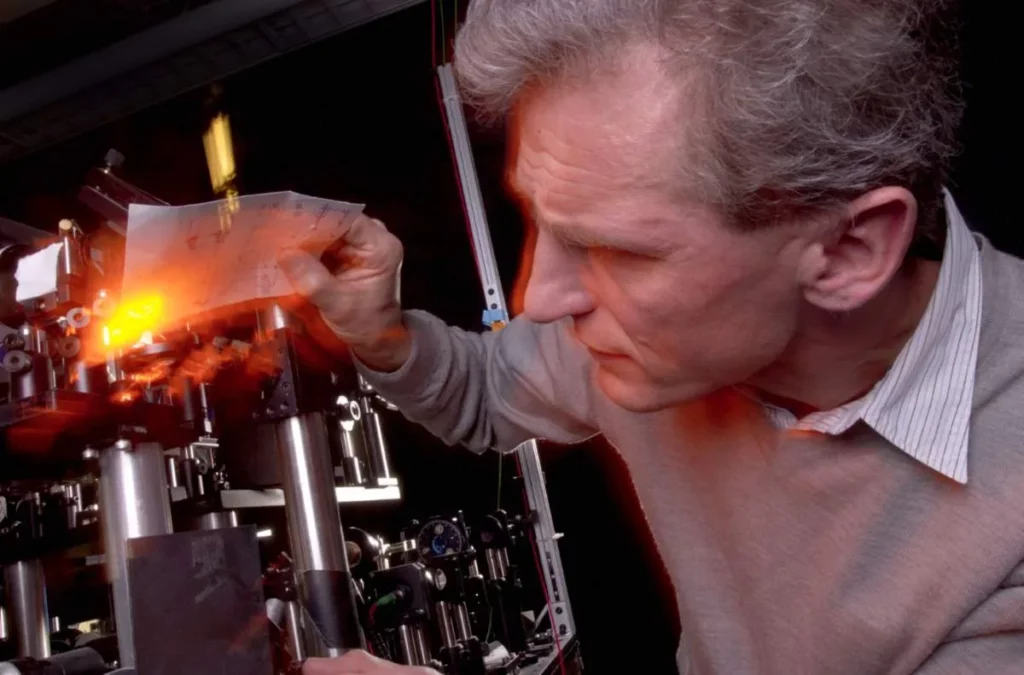
It was 1980 at the Siding Spring Observatory — just outside Coonabarabran, New South Wales, Australia — when Keith Taylor and Mike Scarrott first discovered one of the most stunning nebulas in the history of astronomy. Due to telescopic limitations at the time, the astronomers saw merely a slight asymmetry in its lobes suggesting a curved shape like a boomerang.
From this, the object got its fitting name, the Boomerang Nebula. But little did the researchers know there was much more to their discovery than meets the eye.
It turns out, they discovered the coldest place found in nature.
The coldest place in nature: The Boomerang Nebula
The temperature is so frigid that not even the woolliest of cardigans will save you. Here, particles approach the quantum minimum of speed and the frigid temps reach only one degree Kelvin. For comparison, the Cosmic Microwave Background (CMB)– the background glow left over from the Big Bang – is about 2.8 degrees Kelvin or -270 degrees Celsius. The Boomerang Nebula is the only object in the cosmos colder than the CMB.
Just to get an idea of how chilly that is, at absolute zero (-460 degrees Fahrenheit or -273 degrees Celsius), all atomic motion comes to a standstill since particles stop vibrating. Not even a presidential tweet can move.
The Boomerang Nebula lies 5,000 light-years away from Earth in the constellation Centaurus. At just one degree Kelvin (–457.87 degrees Fahrenheit / –272.15 degrees Celsius), it is colder than the background temperature of space itself, which is generally believed to hover around 2.7 Kelvin (-454.81 degrees Fahrenheit / -270.7 degrees Celsius).
Since Taylor and Scarrot made their discovery, further observations have shown it to be a preplanetary nebula — a sun-like star in its golden years of life when the center nears its timely end and expands the nebula with rapidly outpouring gas.
This outflow from Boomerang is expanding at around 310,000 mph (500,000 kph), and cooling itself in the process. This is similar in principle to the way refrigerators use expanding gas to produce cold temperatures. The researchers were able to measure the temperature of the gas in the nebula by seeing how it absorbed the cosmic microwave background radiation, which has a very uniform temperature of 2.8 degrees Kelvin (-455 degrees Fahrenheit / -270.56 degrees Celsius).
Astronomers using the Atacama Large Millimeter/submillimeter Array (ALMA) telescope in Chile took a new look at this object in 2013 to learn more about its frigid properties and to determine its true shape, an eerily ghost-like appearance. Turns out that the nebula’s shape more closely resembles that of an hourglass rather than a boomerang.

“This ultra-cold object is extremely intriguing and we’re learning much more about its true nature with ALMA,” said Raghvendra Sahai, a researcher and principal scientist at NASA’s Jet Propulsion Laboratory in Pasadena, Calif., and lead author of a paper published in the Astrophysical Journal.
“What seemed like a double lobe, or boomerang shape, from Earth-based optical telescopes, is actually a much broader structure that is expanding rapidly into space.”
This is more than just a piece of information regarding the coldest place in the universe.
“This is important for the understanding of how stars die and become planetary nebulae,” said Sahai. “Using ALMA, we were quite literally and figuratively able to shed new light on the death throes of a Sun-like star.”
When the Aussies originally observed it with ground-based telescopes, the nebula appeared lopsided, but later observations in 2005 with NASA’s Hubble Space Telescope revealed a bow-tie-like structure — so shaped as the gas is ejected at high speed. The new ALMA data, however, reveal that the Hubble image tells only part of the story, and the twin lobes seen in that image may actually be a trick of light as seen at visible wavelengths.
Researchers should have been able to see this bow tie shape at cooler wavelengths as well, but observations with other submillimeter telescopes revealed a somewhat different shape. ALMA, which has the highest resolution yet at the submillimeter wavelength, managed to solve the mystery.
Carbon monoxide molecules in the nebula’s cloud — very bright in this wavelength of light — were in the hourglass shape in the inner parts of the nebula. Further on out, the molecules were arranged in a rounder shape. Meanwhile, dust grains around the star — also visible in millimeter wavelengths — were masking some of the star’s light in visible wavelengths, making it appear as an hourglass.
“When astronomers looked at this object in 2003 with Hubble, they saw a very classic ‘hourglass’ shape,” commented Sahai. “Many planetary nebulae have this same double-lobe appearance, which is the result of streams of high-speed gas being jettisoned from the star. The jets then excavate holes in a surrounding cloud of gas that was ejected by the star even earlier in its lifetime as a red giant.”
Researchers using ALMA also found a dense lane of millimeter-sized dust grains that surrounded the star, explaining why this outer cloud has an hourglass shape in visible light. The dust grains created a mask that shades a portion of the central star and allows its light to leak out only in narrow but opposite directions into the cloud, giving it an hourglass appearance.
Astronomers say that the Boomerang Nebula is on its way to becoming a planetary nebula — a type of nebula that is formed when a star reaches the end of its life and expels its outer layers of gas into space — causing the nebula to glow.
So far, the Boomerang is the only preplanetary nebula that we know of whose temperature has dropped below that of the Big Bang’s afterglow.
The term “planetary nebula” is a misnomer because they are unrelated to planets or exoplanets. The true origin of the term was likely derived from the planet-like round shape of these nebulae as observed by astronomers through early telescopes, and although the terminology is inaccurate, it is still used by scientists.
The preplanetary nebula phase is a short period in the cycle of stellar evolution. Over a few thousand years, the hot remains of the aging star in the center of the nebula heat it up, excite the gas, and make it glow as a subsequent planetary nebula.
The short lifespan of preplanetary nebulae means there are relatively few of them in existence at any one time. Moreover, they are very dim, requiring powerful telescopes to be seen.
This combination of rarity and faintness means they were only discovered comparatively recently. The Egg Nebula, the first to be discovered, was first spotted less than 40 years ago.
And there’s still much we don’t know about the Boomerang Nebula.
“These new data show us that most of the stellar envelope from the massive red giant star has been blasted out into space at speeds far beyond the capabilities of a single, red giant star, ” said Raghvendra Sahai, an astronomer at NASA’s Jet Propulsion Laboratory in Pasadena, California, and lead author on a paper appearing in the Astrophysical Journal.
“The only way to eject so much mass and at such extreme speeds is from the gravitational energy of two interacting stars, which would explain the puzzling properties of the ultra-cold outflow.”
Such close companions may be responsible for the early and violent demise of most stars in the universe, Sahai noted.
“The extreme properties of the Boomerang challenge the conventional ideas about such interactions and provide us with one of the best opportunities to test the physics of binary systems that contain a giant star,” adds Wouter Vlemmings, an astronomer at Chalmers University of Technology in Sweden and co-author on the study.
The actual coldest thing in the universe: a sodium atom cooled below 1 nanoKelvin

It is worth noting that the Boomerang Nebula is the coldest natural place in the universe. The award for the coldest actual place in the world goes to a Cambridge, Massachusetts lab at the Massachusetts Institute of Technology (MIT).
There Wolfgang Ketterle and a team of researchers managed to cool a sodium gas to only half a-billionth of a degree above absolute zero in 1995. It is the first time that a gas was cooled below 1 nanokelvin (one-billionth of a degree).
“To go below one nanokelvin is a little like running a mile under four minutes for the first time,” said the Nobel laureate Ketterle, co-leader of the team. Ketterle is MIT’s John D. MacArthur Professor of Physics. In a lecture at MIT, the laureate also explained how we should look at materials in these ultra-cooled spaces.
“What happens if you take a gas in a container, and cool it down? The particles slow down. As I just mentioned, we shouldn’t describe the particles as sort of little billiard balls. They are wave packets. They are quantum mechanical waves. But as long as the wavelengths is very short, those wave packets are very localized. And we can follow the motion of those wave packets as if they were particles.”
In their achievement, the MIT team, who had paired up with a group of researchers from the University of Colorado at Boulder, discovered a new form of matter, the Bose-Einstein condensate, where the particles march in lockstep instead of flitting around independently.
Since the team’s breakthrough, many groups across the globe now routinely reach nanokelvin temperatures; the lowest temperature reported prior was in the order of one nanokelvin. The record set by the MIT group is 500 picokelvin, or five billion times cooler than the Boomerang Nebula.
At such low temperatures, atoms cannot be kept in physical containers, because they would stick to the walls. Furthermore, no known container can be cooled to such temperatures. Therefore, the atoms are surrounded by magnets, which keep the gaseous cloud confined. “In an ordinary container, particles bounce off the walls. In our container, atoms are repelled by magnetic fields,” explained MIT physics graduate student Aaron Leanhardt.
To reach their temps, the MIT researchers came up with a novel way of confining atoms, which they called a “gravito-magnetic trap.” As the name indicates, the magnetic fields act together with gravitational forces to keep the atoms trapped.
So there you go, two of the coldest places in the universe. Cool, huh?


